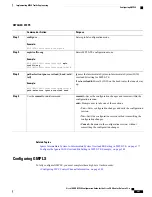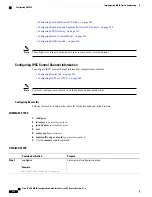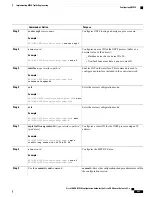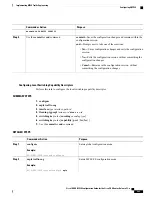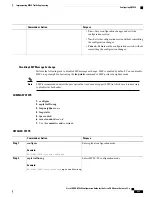
Before You Begin
Only point-to-point (P2P) interfaces are supported for OSPF multiple adjacencies. These may be either
native P2P interfaces or broadcast interfaces on which the
OSPF P2P configuration
command is applied
to force them to behave as P2P interfaces as far as OSPF is concerned. This restriction does not apply to
IS-IS.
The tunnel-te interface is not supported under IS-IS.
Note
SUMMARY STEPS
1.
configure
2.
interface tunnel-te tunnel-id
3.
path-option
[
protecting
]
preference-priority
{
dynamic
[
pce
[
address ipv4 address
] |
explicit
{
name
pathname
|
identifier path-number
} } [
isis instance name
{
level level
} ] [
ospf instance name
{
area area
ID
} ] ] [
verbatim
] [
lockdown
]
4.
Repeat Step 3 as many times as needed.
5.
Use the
commit
or
end
command.
6.
show mpls traffic-eng tunnels
[
tunnel-number
]
DETAILED STEPS
Purpose
Command or Action
Enters global configuration mode.
configure
Example:
RP/0/RP0/CPU0:router# configure
Step 1
Configures an MPLS-TE tunnel interface. The range for
the tunnel ID number is 0 to 65535.
interface tunnel-te tunnel-id
Example:
RP/0/RP0/CPU0:router(config)#
interface tunnel-te
Step 2
1
RP/0/RP0/CPU0:router(config-if)#
Configures an explicit path option for an MPLS-TE tunnel.
OSPF is limited to a single OSPF instance and area.
path-option
[
protecting
]
preference-priority
{
dynamic
[
pce
[
address ipv4 address
] |
explicit
{
name pathname
|
identifier path-number
} } [
isis instance name
{
level level
}
Step 3
] [
ospf instance name
{
area area ID
} ] ] [
verbatim
]
[
lockdown
]
Example:
RP/0/RP0/CPU0:router(config-if)#
path-option 1
explicit identifier 6 ospf green area 0
Cisco IOS XR MPLS Configuration Guide for the Cisco CRS Router, Release 5.1.x
239
Implementing MPLS Traffic Engineering
Configuring MPLS -TE and Fast-Reroute on OSPF

















